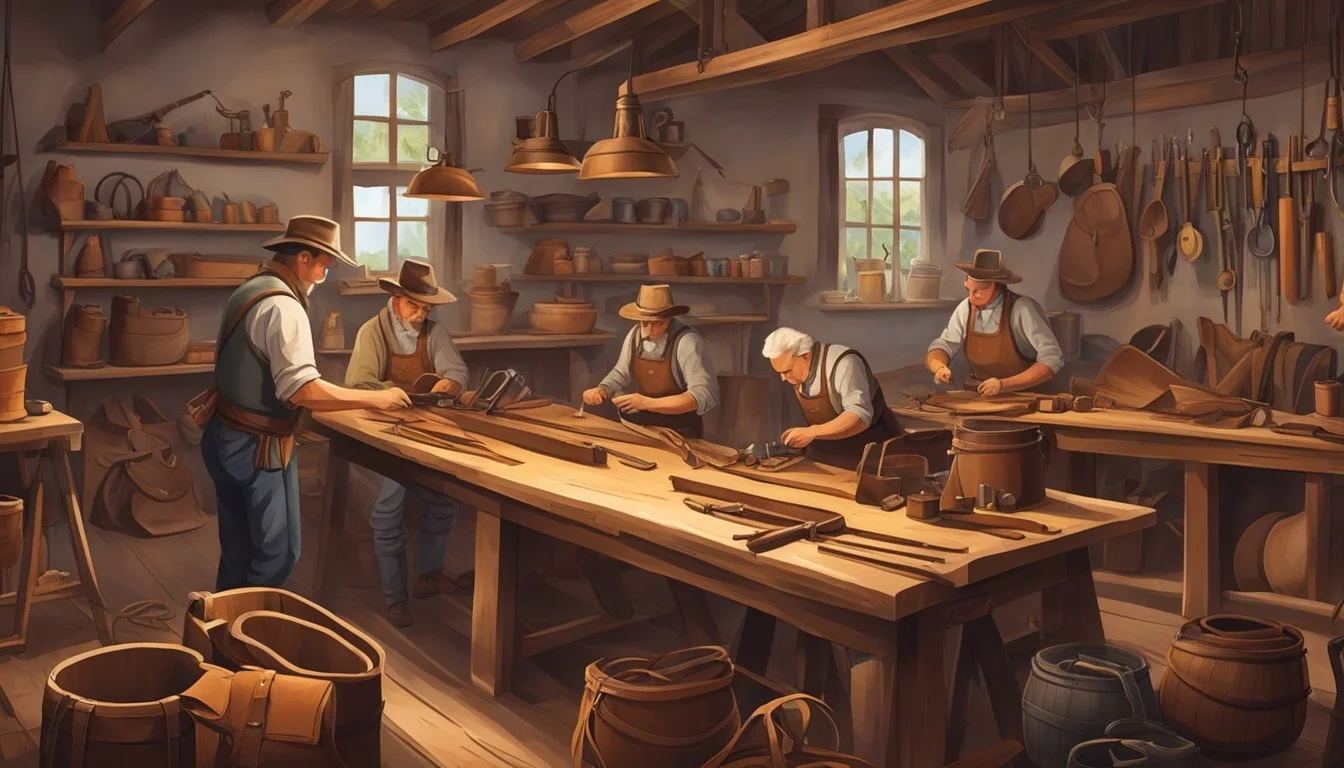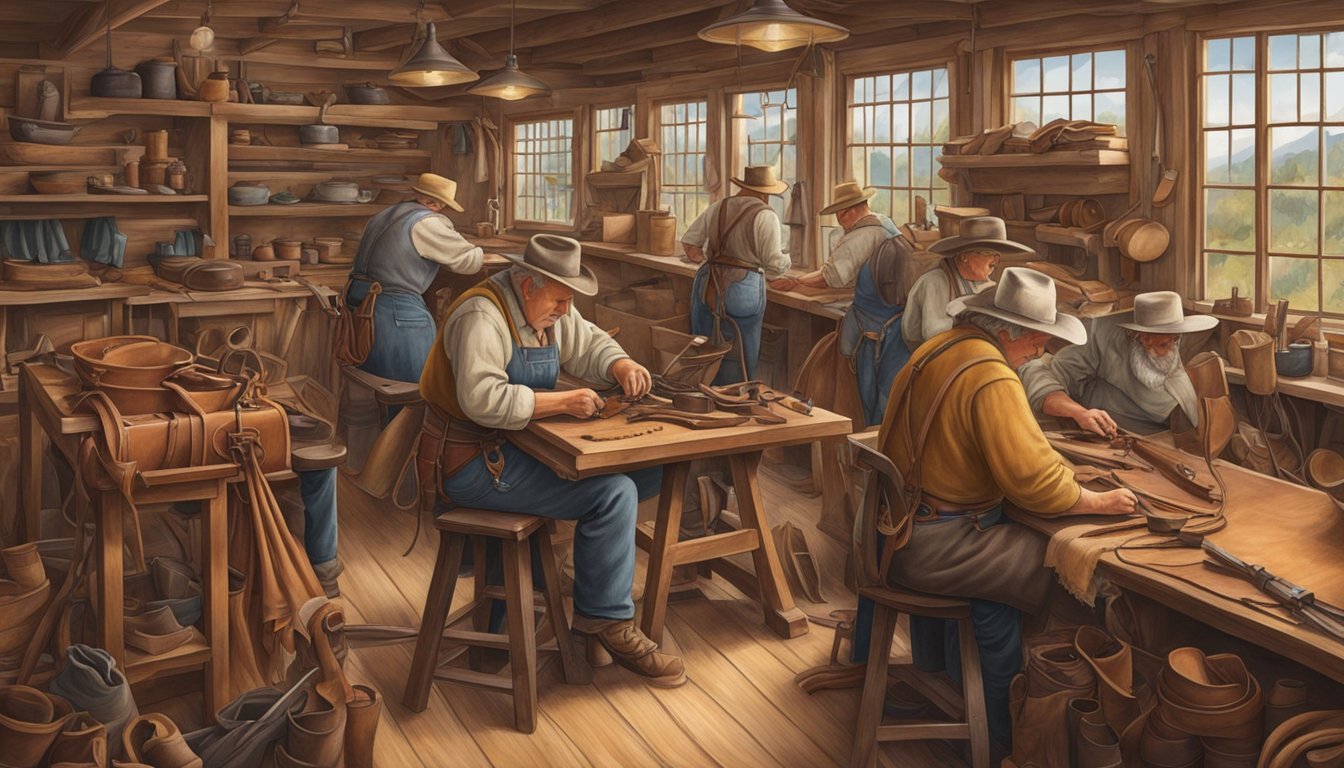The History of German Texan Saddlemakers and Harness Makers
Craftsmanship Crosses Continents
The history of Texas is deeply intertwined with the traditions and crafts brought by immigrants, including an influential community of German Texans. These skilled artisans, who migrated to Texas in the 19th century, left a lasting mark on the local economy through their unique contributions to the craft of saddlemaking and harness making. They seamlessly blended their rich heritage with the necessities of Texan life, producing durable and practical goods that were essential for the agrarian lifestyle of the period.
In a land where the horse was central to everyday life and work, the demand for quality saddles and harnesses was substantial. German Texan saddlemakers capitalized on this need, establishing themselves as meticulous craftsmen. Their commitment to quality and adherence to traditional techniques set them apart, leading them to become respected members of their communities. They were not only integral in the development of local saddlemaking but also played a crucial role in the growth of Texas' leather industry as a whole.
Harness makers, who were often saddlemakers as well, provided a range of leather goods, from custom-made harnesses vital for securing horses to carts and plows, to other essential items like boots, bags, and belts. The durability and longevity of their products were a testament to the German influence on Texan craftsmanship—a fusion of heritage and localized innovation that has contributed to the state's rich cultural tapestry.
German Texans: Origins and Migration
German immigrants significantly shaped the cultural landscape of Texas during the 19th century, establishing strong communities with lasting traditions and customs, particularly in the realms of saddlery and harness making.
Early Immigration and Settlement Patterns
German migrants began arriving in Texas during the 1830s, with a substantial increase in the 1840s. These immigrants predominantly settled in the south-central part of Texas known as the Texas Hill Country, establishing notable towns such as New Braunfels and Fredericksburg. The settlement patterns were typically in rural areas where land was suitable for farming, but they also had a considerable hand in trade and skilled crafts, like saddle and harness making.
Immigrants to Texas from Germany:
1830s: Small groups of German immigrants started to arrive.
1840s: Marked the peak of German immigration, with larger groups forming settlements.
Sociopolitical and Cultural Factors Influencing Migration
Several factors in Germany propelled migration to Texas, such as economic hardship, political unrest, and a desire for religious freedom. The Adelsverein, formally known as the Society for the Protection of German Immigrants in Texas, played a critical role. This organization facilitated the migration and settlement process, helping to preserve German customs and the German language within Texas.
Migration Motivators:
Economic hardship: Lack of opportunities in Germany pushed many towards new prospects in Texas.
Political unrest: The tumultuous political climate in Germany spurred people to seek stability abroad.
Religious freedom: Germany's varied religious tapestry sought expression without constraint.
Establishment of German Communities in Texas
Upon arrival, Germans in Texas established tight-knit communities, maintaining their language and customs and eventually contributing significantly to the state's cultural identity. The Texas Hill Country became a hub for German settlers. Here, they founded institutions such as schools and churches where German traditions thrived. Organizations like the Verein, equivalent to cultural clubs, reinforced communal bonds and facilitated the integration of their cultural heritage into the broader Texas society. The skill of saddlery and harness making flourished with these settlers, cementing their importance within Texas's economic framework.
German Community Formation:
German-speaking schools and churches: Crucial in preserving traditions.
Craftsmanship in settlements: Saddlery and harness making emerged as respected trades.
Saddlemaking and Harness Making: An Overview
The heritage of German Texan saddlemakers and harness makers is a vivid chapter in the cultural tapestry of Texas, reflecting an enduring legacy of leather craftsmanship and the essential role of saddles and harnesses in ranching society.
Introduction to Leather Craftsmanship
German Texan craftsmen excelled in leather work, contributing significantly to the ranching industry with their high-quality saddles and harnesses. Utilizing locally sourced leather, these artisans combined traditional German techniques with the demands of Texan cattle-handling to create functional, durable goods.
Evolution of German Texan Saddlemaking
Throughout the years, German Texan saddlemakers have honed their designs to meet the challenges of the western frontier. Emphasizing both form and function, these saddlemakers produced western saddles known for their practicality and aesthetic appeal. The convergence of German precision and Texan ruggedness led to saddle artifacts that are now both valued as material culture and as collectors' items.
Harness Makers and Their Role in Texan Society
Harness makers were indispensable in a society where horsepower was literal. Crafting everything from simple work harnesses to intricate carriage adornments, they provided essential tools for the transport of goods and people. German Texan harness makers were recognized for their role in maintaining the flow of daily life and commerce, underpinning the cattle-driven economy of the Texan region.
Cultural Impact and Legacy
German Texan saddlemakers and harness makers contributed significantly to the state's material culture through their craftsmanship and preservation of heritage. Their legacy extends beyond leatherwork, impacting music, festivals, language, and education within Texas.
Preservation of German Texan Material Culture
The material culture of German Texans, including the art of saddlemaking and harness crafting, is preserved through various artifacts housed in museums across Texas. Exhibits showcase meticulously crafted leather goods, demonstrating the skill and dedication of German Texan artisans. These pieces not only tell the story of individual craftsmen but also reflect the broader heritage of the German community in Texas.
Influence on Texas Music and Festivals
German Texan saddlemakers and harness makers have indirectly influenced the cultural landscape through community gatherings and festivals. Events like Wurstfest and Oktoberfest celebrate German Texan culture, often featuring traditional music where the accordion, a fixture in German folk bands, plays a prominent role. These festivals foster a sense of connection and continuity, celebrating the multifaceted impact of German Texans on the state's culture.
German Texan Contribution to Language and Education
The influence of German Texan craftsmen extends to language and education. Many towns in Texas still retain the German language in some form, and various schools and colleges offer courses in German, recognizing the importance of maintaining linguistic diversity. Additionally, the history and techniques of German Texan leatherworking are studied in university programs related to cultural heritage and arts, ensuring that this aspect of Texas history is both understood and appreciated by new generations.
Social and Economic Influence
The German Texan saddlemakers and harness makers played a pivotal role in Texas’s economic development, contributing significantly to the state's agricultural and architectural advancements. They were essential in supporting the needs of the ranching and farming communities, as well as influencing the state's trade and commerce.
The Role in Texas's Agricultural Development
German Texan craftsmen were instrumental in supporting Texas's burgeoning cattle and ranching industry. They provided durable saddles and harnesses necessary for the cattle drives that became the backbone of the rural economy. German Texan saddlemakers understood the rigorous demands of agriculture and tailored their products to meet these needs, thus directly affecting the productivity and efficiency of ranching operations.
Commercial Expansion of Saddlemaking and Harness Making
The commerce associated with saddlemaking and harness making saw notable growth as cattle ranching and farming expanded. Saddlemakers and harness makers established workshops that stimulated local economies, generating trade and fostering a demand for quality craftsmanship. Their businesses sold products not just locally but also shipped to other states, showing how industry and commerce were interwoven in the economic fabric of German Texan communities.
Contribution to Construction and Architecture
German Texan carpenters and blacksmiths also contributed to the area’s development in construction and architecture. The distinctive style of Fachwerk, a traditional German half-timbered construction method, became prevalent in local architecture. Saddlemakers and harness makers often collaborated with carpenters to provide leather components for building tools and materials for construction, integrating their trade into the wider economic activities connected to architecture and growth.
Adversities and Resilience
The history of German Texan saddlemakers and harness makers is marked by both significant difficulties and remarkable tenacity. They encountered ethnocentric challenges that tested their cultural identity and professional endurance.
Anti-German Sentiment and Its Effects
During World War I, German Americans, including those in Texas, faced widespread anti-German sentiment. This manifested in various ways, from social ostracism to economic repercussions. German Texan saddlemakers were often stereotyped and even boycotted, leading to a decline in business. The pressure was potent enough that many felt compelled to downplay their heritage, changing names of businesses and products to avoid any association with Germany.
Impact on Craftsmanship:
Decline in traditional German techniques
Loss of custom from German Texan communities
German Texan Identity During 20th Century Conflicts
With the outbreak of World War II, German Texans, much like during the First World War, were confronted with a resurgence of anti-German sentiment. Despite these challenges, German Texan saddlemakers maintained resilience, finding ways to sustain and adapt their craft. Post-war, they contributed significantly to the unique Texan identity—a blend of American and German influences seen in the designs of their saddles and harnesses.
Preservation of Heritage:
Incorporation of German designs discreetly
Silent upkeep of German Texan traditions within communities
Their resilience in the face of adversity is a testament to the enduring spirit of the German Texan craftspeople. Despite economic downturns and cultural pressures, their contributions have left an indelible mark on Texan, and particularly ranching, heritage.
Conclusion
German Texans have significantly contributed to the trade of saddle and harness making, integrating their heritage with local Texan culture. They brought with them a rich tradition of craftsmanship, which when merged with Texan needs, resulted in durable and high-quality saddlery that was essential for ranching operations.
Heritage: The German influence in this industry is paramount; their dedication to the craft can be seen in the meticulous attention to detail and the enduring quality of their products. Traditional German practices, when applied to saddle making, have ensured that their work remains sought after.
Saddle and Harness Maker: Their expertise in working with leather has been passed down through generations, showcasing a depth of knowledge in a highly specialized field. German Texan craftsmen managed to withstand the test of economic fluctuations, such as the decline seen during the 1920s and the Great Depression.
Education: The transfer of knowledge has not been formalized in educational institutions but rather conveyed through hands-on experience and apprenticeships. This mode of education has allowed for the consistent creation of high-caliber saddles and harnesses specifically tailored to the needs of the Texan environment.
In modern times, the impact of German Texan saddle and harness makers is evident across the state. They have not only contributed to the state's economic history but have also left an indelible mark on its cultural heritage. Although their prominence may have diminished due to various socioeconomic changes, the legacy of their craftsmanship continues, celebrated by collectors and history enthusiasts alike.







